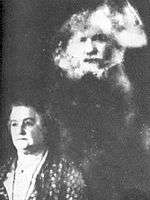Spirit photography
.jpg)
Spirit photography is a type of photography whose primary attempt is to capture images of ghosts and other spiritual entities, especially in ghost hunting and has a strong history dating back to the late 19th century.[1]
History
Spirit photography was first used by William H. Mumler in the 1860s.[1] Mumler discovered the technique by accident, after he discovered a second person in a photograph he took of himself, which he found was actually a double exposure. Seeing there was a market for it, Mumler started working as a medium, taking people's pictures and doctoring the negatives to add lost loved ones into them (mostly using other photographs as basis). Mumler's fraud was discovered after he put identifiable living Boston residents in the photos as spirits.

Other spirit photographers also started to sell photographs. A later spirit photographer was Fred A. Hudson, who took many spirit photographs for spiritualists in 1872. Through the 1880s into the early 20th century spirit photography remained popular, with notable proponents such as Arthur Conan Doyle and William Crookes.[2][3] William Stainton Moses, another spiritualist, claimed that spirit photography operated by means of a fluid substance called ectoplasm, in which the spirits take form.[4] Some spiritualists authored books supporting spirit photography. Georgiana Houghton wrote Chronicles of the Photographs of Spiritual Beings and Phenomena Invisible to the Material Eye (1892) and James Coates wrote Photographing the Invisible (1911).
One of the later spirit photographers was William Hope (1863–1933). The psychical researcher Harry Price revealed that the photographs of Hope were frauds. Price secretly marked Hope's photographic plates, and provided him with a packet of additional plates that had been covertly etched with the brand image of the Imperial Dry Plate Co. Ltd. in the knowledge that the logo would be transferred to any images created with them. Unaware that Price had tampered with his supplies, Hope then attempted to produce a number of Spirit photographs. Although Hope produced several images of spirits, none of his materials contained the Imperial Dry Plate Co. Ltd logo, or the marks that Price had put on Hope's original equipment, showing that he had exchanged prepared materials containing fake spirit images for the provided materials.[5][6]
Hope still retained a noted following from spiritualists such as Charles Lakeman Tweedale author of Man's Survival After Death (1920) as well as the author and spiritualist Arthur Conan Doyle, who refused to accept any evidence that Hope was a fraud and went to great lengths to clear his name, including writing a book supporting spirit photography, The Case for Spirit Photography (1922).[7] In his book Fifty Years of Psychical Research, Price listed many spirit photographers who had been exposed as frauds.[8] Price who had spent most of his life studying psychical phenomena wrote that "There is no good evidence that a spirit photograph has ever been produced."[9] Which is also the view of most psychical researchers.[10]
Other spirit photographers exposed as frauds include David Duguid and Edward Wyllie.[11] Ronald Pearsall exposed the tricks of spirit photography in his book The Table-Rappers (1972).[12]
See also
References
- 1 2 Ogden, Tom (1999). The Complete Idiot's Guide to Ghosts and Hauntings. Alpha Books. pp. 107–108. ISBN 978-0-02-863659-7.
- ↑ Sarah A. Willburn. (2006). Possessed Victorians: extra spheres in nineteenth-century mystical writings. pp. 58-59
- ↑ Jennifer Tucker. (2005). Nature exposed: photography as eyewitness in Victorian science. p. 253
- ↑ Arthur Conan Doyle. (1926). The History of Spiritualism, Volume 1. p. 71
- ↑ Harry Price. (1933). Leaves from a psychist's case-book.
- ↑ Massimo Polidoro. Photos of Ghosts: "The Burden of Believing the Unbelievable". Committee for Skeptical Inquiry.
- ↑ Arthur Conan Doyle. (1922). The Case for Spirit Photography.
- ↑ Harry Price. (2003). Fifty Years of Psychical Research. Kessinger Reprint Edition. p. 35
- ↑ John Mulholland. (1975). Beware Familiar Spirits. p. 152
- ↑ Lewis Spence. (2011). Encyclopedia of Occultism and Parapsychology. Kessinger Publishing.
- ↑ Joe Nickell. (2001). Real-Life X-Files: Investigating the Paranormal. The University Press of Kentucky. pp. 260-261. Also see Joe Nickell. (2005). Camera Clues: A Handbook for Photographic Investigation. The University Press of Kentucky. p. 151
- ↑ Ronald Pearsall. (1972). The Table-Rappers. Book Club Associates. pp. 118-125
Further reading
- James Black (1922). The spirit-photograph fraud: The evidence of trickery, and a demonstration of the tricks employed. Scientific American, 127, 224–225, 286.
- Kaplan Louis (2008). The Strange Case of William Mumler, Spirit Photographer. University of Minnesota Press.
- Cyril Permutt (1983). Beyond the Spectrum: Survey of Supernormal Photography Patrick Stephens Publishers Ltd; 1st edition ISBN 0-85059-620-3
- Walter Franklin Prince (1925, December). My doubts about spirit photographs. Scientific American, 133, 370–371.